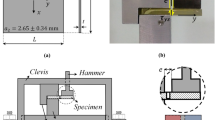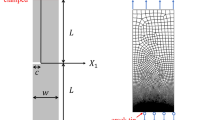Abstract
This study contributes towards understanding crack toughness as resistance against the intrinsic rate of fracture mechanics parameters. Up to now only few investigations have been done under moderate impact loading conditions. Based on experimental investigations using the crack resistance (R) concept, it has been shown that the stop block method combined with the multiple-specimen technique is a unique method for polymers under impact loading conditions in comparison with different R-curve methods. Other methods for the determination of R curve such as the low-blow technique are normally not applicable for polymers due to their time-dependent mechanical properties. The crack-tip opening displacement (CTOD) rate is a measurement of the rate sensibility of stable fracture process depending on the type of deformation, which can provide deep insights into the micromechanics and activation mechanisms during the fracture processes. In the polymeric materials mostly investigated, one can understand the stable crack propagation with three-stage processes; crack-tip blunting/crack initiation, non-stationary stable crack growth and steady-state stable crack growth (an equilibrium state). In this stable crack propagation, the values of normalized CTOD rate converge rapidly to a ‘matrix’-specific threshold. The stop block method in the multiple-specimen technique assures the criteria of the time-independent strain field around the crack tip and constant crack speed therewith and the J-integral is a valid toughness parameter.
Similar content being viewed by others
Abbreviations
- ABS:
-
acrylonitrile–butadiene–styrene copolymer
- ASTM:
-
American Society for Testing and Materials
- CD:
-
particle centre-to-centre distance
- CTOD:
-
crack-tip opening displacement
- EPR:
-
ethylene–propylene random copolymer
- ESIS TC4:
-
European Structural Integrity Society, Technical Committee 4: Polymers and Composites
- MST:
-
multiple-specimen technique
- PB:
-
polybutadiene
- PC:
-
polycarbonate
- PE:
-
polyethylene
- PE-HD:
-
high-density polyethylene
- PP:
-
polypropylene
- PS:
-
polystyrene
- R:
-
crack resistance
- SB:
-
styrene–butadiene
- SST:
-
single-specimen technique
- TPU:
-
polyurethane based thermoplastic elastomer
References
Agarwal, B.D. and Giare, G.S., ‘Crack-growth resistance of short fibre composites. 1. Influence of fibre concentration, specimen thickness and width’, Fibre Sci. Technol. 15, 1981, 283–298.
Agarwal, B.D. and Giare, G.S., ‘Crack-growth resistance of short fibre composites. 2. Influence of test temperature’, Fibre Sci. Technol. 16, 1982, 19–28.
Anderson, T.L., Fracture Mechanics Fundamentals and Applications, 2nd ed., CRC Press, Boca Raton, 1995.
ASTM D 6068, Standard Test Method for Determining J-R Curves of Plastic Materials, ASTM, Philadelphia, 1996.
Blumenauer, H. and Schroeder, M., ‘Anwendung des registrierenden Schlagversuches zur Prüfung von Plastwerkstoffen’, Plaste Kautsch. 20, 1973, 832–833.
Bradley, W., Cantwell, W.J. and Kausch, H.H., ‘Viscoelastic creep crack growth: A review of fracture mechanical analysis’, Mech. Time-Depend. Mat. 1, 1998, 241–268.
Bueche, F., ‘Tensile strength of plastics above the glass temperature’, J. Appl. Phys. 26, 1955, 1133–1140.
Christensen, R.M., ‘Rate-dependent criterion for crack growth’, Int. J. Fract. 15, 1979, 3–21.
Christensen, R.M. and Wu, E.M., ‘A theory of crack-growth in viscoelastic media’, Eng. Fract. Mech. 14, 1981, 215–225.
Dear, J.P., ‘Comparison of fast fracture properties of thermoplastics’, Polymer Eng. Sci. 36, 1996, 1210–1216.
Frassine, R., Rink, M., Leggio, A. and Pavan, A., ‘Experimental analysis of viscoelastic criteria for crack initiation and growth in polymers’, Int. J. Fract. 81, 1996, 55–75.
Grellmann, W. and Lach, R., ‘Effect of temperature on toughness, fracture surface morphology and molecular relaxation behaviour of polycarbonate’, Appl. Macromol. Chem. Phys. 237, 1996, 191–208.
Grellmann, W. and Seidler, S. (eds.), Deformation and Fracture Behaviour of Polymers, Springer, Berlin, 2001.
Horst, T. and Heinrich, G., ‘Modellierung der Rissausbreitung in verstärkten polymeren Werkstoffen’, Proceeding of Polymerwerkstoffe 2004, Halle (Saale), 2004, PII-45.
Kalthoff, J.F., Beinart, J. and Winkler, S., ‘Measurement of dynamic stress intensity factors for fast running and arresting cracks in double-cantilever beam specimens’, ASTM Special Technical Publications 627, 1977, 161–176.
Kausch, H.H., ‘Recent developments in the kinetic theory of fracture of polymers’, Kolloid ZZ für Polym. 236, 1970, 48–58.
Kausch, H.H., ‘Rate process theories of polymers’, in Polymer Fracture, 2nd ed., Springer, Berlin, Chapter 3.IV, 64–83, 1987.
Knaus, W.G., ‘Time Dependent Fracture in Polymers’, in Advances in Fracture Research, Proceedings of the 7th International Conference on Fracture (ICF 7), Houston, Texas, 20–24 March 1989, Salama, K., Ravi-Chandar, K., Taplin, D.M.R. and Rao Rama, P. (eds.), Pergamon Press, Oxford, 1989, Vol. 4, 2683–2711.
Lach, R., Adhikari, R., Weidisch, R., Huy, T.A., Michler, G.H., Grellmann, W. and Knoll, K., ‘Fracture toughness behavior of binary styrene-butadiene block copolymer blends’, J. Mat. Sci. 39, 2004, 1283–1295.
Schapery, R.A., ‘Theory of crack initiation and growth in viscoelastic media. 1. Theoretical development’, Int. J. Fract. 11, 1975a, 141–159.
Schapery, R.A., ‘Theory of crack initiation and growth in viscoelastic media. 2. Approximative methods of analysis’, Int. J. Fract. 11, 1975b, 369–388.
Schapery, R.A., ‘Theory of crack initiation and growth in viscoelastic media. 3. Analysis of continuous growth’, Int. J. Fract. 11, 1975c, 549–562.
Standard Draft of ESIS TC4, A testing protocol for conducting J-crack growth resistance curve tests on plastics, ESIS TC4, 2000.
Zhurkov, S.N., ‘Kinetic concept of the strength of solids’, Int. J. Fract. 1, 1965, 311–323.
Author information
Authors and Affiliations
Corresponding author
Rights and permissions
About this article
Cite this article
Lach, R., Seidler, S. & Grellmann, W. Resistance Against the Intrinsic Rate of Fracture Mechanics Parameters for Polymeric Materials Under Moderate Impact Loading. Mech Time-Depend Mater 9, 103–119 (2005). https://doi.org/10.1007/s11043-005-1084-y
Received:
Accepted:
Issue Date:
DOI: https://doi.org/10.1007/s11043-005-1084-y




